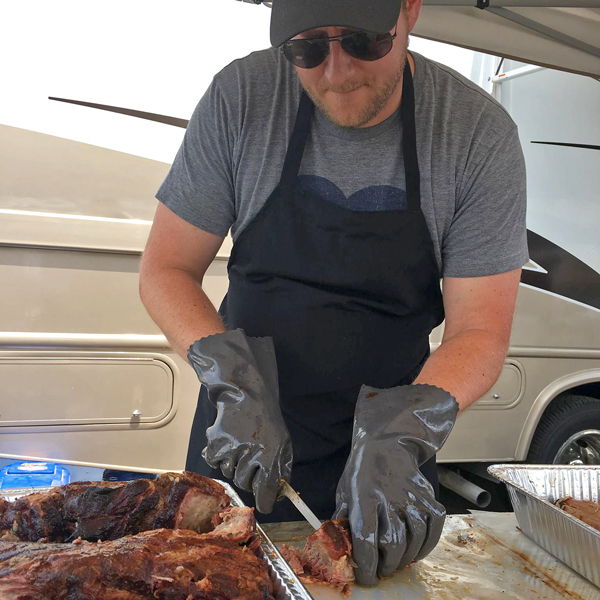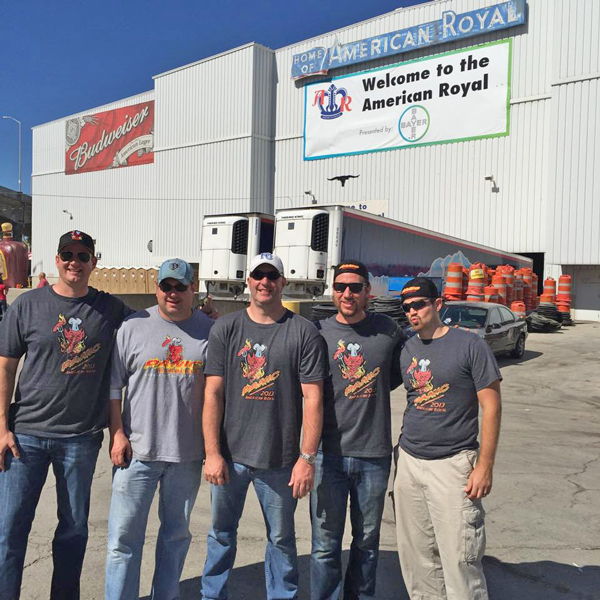Don't Panic it's just BBQ
People in Kansas City take barbecue very seriously and President & CEO at KC Tech Council Ryan Weber (Kansas State University, 2005) is no exception. Weber is just one piece of the Panic Barbecue team and although he still considers himself an amateur, it does not stop him and his friends from turning out good elevated barbecue.


How did you get started in competitive barbecue?
There are several competitions throughout the year that teams can compete against each other and they range from 20 to 600 teams. The American Royal is the World Series of barbecue and it is hosted here in Kansas City every fall. A little over 10 years ago, a friend of mine was putting together a team and asked if I would help and get involved. Since then, we’ve been competing in the American Royal every year. We compete in the open competition, so it’s literally your backyard barbecue heroes as well as your TV shows and barbecue pitmaster people—all competing together.
How did you come up with the name of your team?
The founder of the group is a big fan of the band, Widespread Panic, so that’s how clever he was with the name of the team.
Do you compete with the same group for every event?
Yes, it typically the same core group. There are four or five people team members that go to every single competition and a handful of people who come in and out based on availability.
How does the team break down responsibilities?
When we first started, we went in with no strategy. After a team meeting, we would come up with a plan of times we wanted to start cooking things, at what temperature, how we want to prep, etc. Now, one of us will take the lead on a certain kind of meat. At these barbecue competitions, you’re competing in ribs, chicken, brisket, pork butt and sausage. I usually take the lead on one or two of those. It’s a whole team effort.


What was it like getting started and competing with side pros?
I will say the first four or five years we competed, it was really bad. It’s a science experiment because there are turning times, certain ways you have to turn in meat and it has to be presented in a certain way plus taste a certain way. Judges go off appearance first and then taste and tenderness second. There’s an overall score given to you based on those three categories and then other judges review it. We were really bad at first, until the last couple of years. Our quality and seriousness have gone up a lot.
After competing for a while, how has the team grown?
We have gotten a lot more strategic in networking with the people who went [to competitions] and learning about their strategies and their rubs and seasonings. We have modeled a lot of our recent effort on what the pros do and it has paid off significantly. So that they could understand what the judges are looking for, a couple of our team members went [to competitions] and they learned to become certified judges. We have even changed the kind of meat and where we’re getting that meat from. For example, we use wagyu briskets—which are pretty expensive. They can be $200 to $300 apiece, which is part of it.
How have your grills and equipment changed over the years?
We used to use a pretty standard sidebox smoker, where you have a firebox on the side, you have a bomb chamber where your meat is and then two at the end that takes the smoke out of that chamber. We upgraded significantly from the first year when we had a Weber kettle grill and a sidebox smoker, to this last year, where we had a large Traeger smoker. We also use an American Barbecue System (ABS). The ABS is the largest one they have. It has a six-rack rotisserie in it and it burns your pellets as well as a stick burner to keep a consistent temperature. So you put charcoal and wood in the back and you’ve got a firebox upfront that burns pellets. It’s all computerized. We have Bluetooth sensors that give us the ambient temperature of each smoker, but also the temperature inside each of the meats. Then we project the data onto a TV screen, so at any point in time, we know the temperature of the smokers and the meat. We’ve also got alarms and sensors set up in case the temperatures drop too low or in case the temperature of the meat is rising too fast. It also tells us when it’s done. So we’re able to pull off the meat and within a certain couple of degrees of temperature. For meats like brisket, that is really important. You can’t have a lot of swings in temperature or your brisket could be really tough and dry.
What is one thing you were surprised to learn while competing?
It’s all about one bite. The judge has to get all of the flavor, texture and everything, out of one bite. It’s not meat that you would feed to your family, necessarily, it’s pretty rich. It’s salty, sweet and a little bit spicy, a lot is going on in that one bite. But, to get that flavor profile, including smoke and all that, it’s quite a process.
What advice would you give to people trying to up their barbecue game?
There are so many great resources that are available online. I would be lying if I didn’t tell you that YouTube has been one of the best ways to see what the top competitors are doing as far as their technique, their style and the rubs and sauces that they’re using. The pros are pretty transparent about what they’re doing so that even if you’re just trying to cook in your backyard with friends and family, they are able to help elevate your barbecue. However, certain principles will never change. You have to have good quality meats. You’ve got to invest in high-quality rubs and sauces and then you’ve got to understand the techniques that people use to produce high-quality barbecue.
The American Royal
The first American Royal Barbecue Contest was held in 1980 and quickly grew in popularity. In 1998, it officially became the “The World’s Largest Barbecue” with 340 teams competing. 2020 will mark the 41st year of fire and smoke. Competitors from around the world come together for the chance to be crowned the grand champion in the Invitational Competition, Open Competition, Sides Competition and Kids Que.
